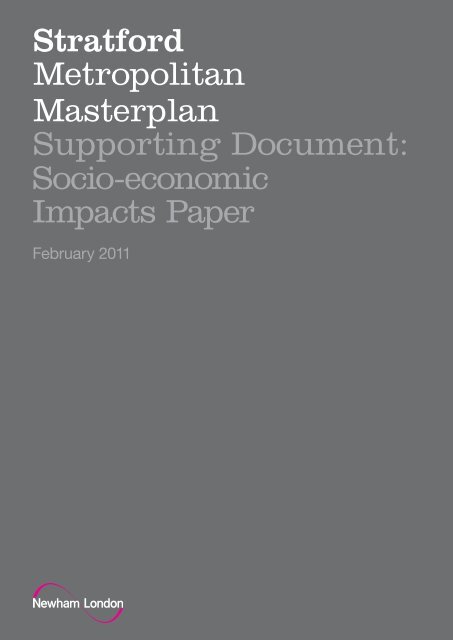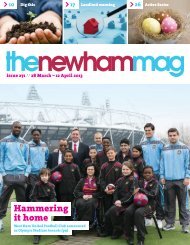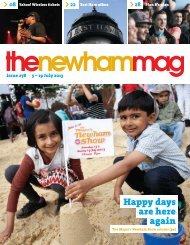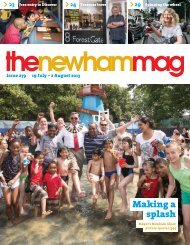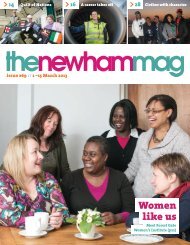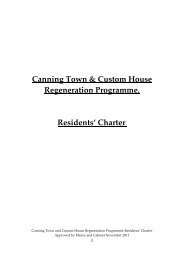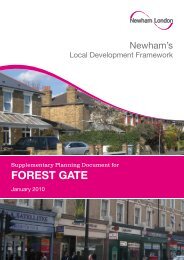Stratford Masterplan: Socio-economic impact paper - Newham
Stratford Masterplan: Socio-economic impact paper - Newham
Stratford Masterplan: Socio-economic impact paper - Newham
Create successful ePaper yourself
Turn your PDF publications into a flip-book with our unique Google optimized e-Paper software.
<strong>Stratford</strong><br />
Metropolitan<br />
<strong>Masterplan</strong><br />
Supporting Document:<br />
<strong>Socio</strong>-<strong>economic</strong><br />
Impacts Paper<br />
February 2011
Final version approved by London Borough of<br />
<strong>Newham</strong> Cabinet on 16th December 2010.<br />
Copyright London Borough of <strong>Newham</strong> 2011<br />
www.newham.gov.uk/stratfordmetropolitan<br />
Supported by Shared Intelligence, DTZ, Halcrow,<br />
Urban Space Management and Arup.
CONTENTS<br />
1. Introduction ............................................................................. 1<br />
2. Executive Summary.................................................................. 1<br />
Jobs, Business & Enterprise ..........................................................1<br />
Combatting Worklessness ............................................................2<br />
Visitor Economy..........................................................................2<br />
Investment ................................................................................3<br />
Movement..................................................................................3<br />
Housing .....................................................................................3<br />
Population Growth and Change .....................................................4<br />
Access to Services.......................................................................4<br />
Cultural and Leisure Opportunities.................................................4<br />
Safer, Greener <strong>Newham</strong>...............................................................5<br />
3. Jobs.......................................................................................... 6<br />
Baseline.....................................................................................6<br />
Desktop review of forecasts for <strong>Stratford</strong>’s Job Growth .....................6<br />
How the <strong>Masterplan</strong> will Create Jobs ............................................ 10<br />
4. Business and Enterprise ......................................................... 16<br />
Business Growth ....................................................................... 16<br />
Defining Employment Growth ..................................................... 17<br />
Combatting Worklessness .......................................................... 20<br />
Visitor Economy........................................................................ 20<br />
5. Investment............................................................................. 22<br />
6. Movement .............................................................................. 23<br />
7. Housing .................................................................................. 24<br />
8. Population Growth and Change .............................................. 26<br />
9. Access to Services .................................................................. 29<br />
10. Cultural and Leisure Opportunities ......................................... 30<br />
11. Safer, Greener <strong>Newham</strong> ......................................................... 31
1. INTRODUCTION<br />
1.1. <strong>Stratford</strong> Metroplolitan masterplan brings together a wide range of existing and<br />
proposed plans in such a way as to maximise their <strong>impact</strong> for the people of<br />
<strong>Stratford</strong>, <strong>Newham</strong> and East London. The masterplan encapsulates the real and<br />
tangible opportunity for positive change in <strong>Stratford</strong> that can secured if it is<br />
guided by a clear and comprehensive vision shared by the main stakeholders.<br />
This could mean real change in the everyday lives of the millions of people who<br />
live, work, shop, play, study and move through <strong>Stratford</strong>. It could provide a<br />
better place to live, a safer street to move along, a new opportunity for work or<br />
learning, a healthier and happier community. Some of the key <strong>impact</strong>s that<br />
could arise from the masterplan alongside other development and investment<br />
coming forward in the area are set out below.<br />
2. EXECUTIVE SUMMARY<br />
Jobs, Business & Enterprise<br />
2.1. Over 46,000 jobs will be provided across <strong>Stratford</strong>, including 7,400 jobs in the<br />
existing town centre, 3,500 on the Olympic site, and over 30,000 at <strong>Stratford</strong><br />
City.<br />
2.2. These include over 33,000 office jobs, 10,400 retail jobs, over 1,500<br />
leisure/education and community jobs and also over 1,000 jobs in hotels and<br />
catering.<br />
2.3. Of the 33,000 office jobs, the largest sector will be finance and business<br />
services. Public sector employment will become a smaller, though still<br />
significant, contributor to overall employment (over 4,000 jobs).<br />
2.4. The area will become increasingly attractive to innovative, knowledge intensive<br />
companies.<br />
2.5. It is estimated that growth over the plan period could result in 1,700 new<br />
workplaces in the <strong>Stratford</strong> and New Town ward. The largest proportion of<br />
these would be small businesses, though large companies will make the<br />
biggest contribution to job creation. In particular, the area would respond to<br />
the opportunities for growth of the following sectors:<br />
business and financial services,<br />
retail,<br />
visitor economy (hotels, tourism & leisure),<br />
creative industries,<br />
knowledge intensive sectors (education; high technology and green<br />
industries),<br />
construction.<br />
SHARED INTELLIGENCE 1
2.6. As <strong>Stratford</strong>’s enterprise structure changes, the mix of companies and sectors<br />
would become more like those associated with London’s Central Activity Zone<br />
and its city fringes.<br />
Combatting Worklessness<br />
2.7. To ensure that the proportion of working age people in work in <strong>Newham</strong> is the<br />
same as the London average, 21,000 Borough residents need to secure work.<br />
Unemployed people, especially the long-term unemployed, are more likely to<br />
have lower skill levels than people in employment.<br />
2.8. <strong>Stratford</strong>’s employment growth is a resource for tackling worklessness across<br />
the Borough as a whole. <strong>Stratford</strong>’s growth will help in a number of ways:<br />
<br />
<br />
<br />
Development will create a substantial increase in lower skilled level jobs in<br />
retail and services, for example: Westfield will add over 8000 retail jobs to<br />
the local economy, and in the medium term, over 1,000 jobs in hotels and<br />
catering will be created.<br />
Employment services including Workplace and the Mayor’s Employment<br />
Project will be extended and dedicated projects such as the Westfield<br />
Training Academy will link local people with jobs.<br />
The education sector will be strengthened at all levels, and new higher<br />
education establishments will be attracted into the area, to provide high<br />
quality academic and vocational learning.<br />
Visitor Economy<br />
2.9. The Olympics are providing a once in a lifetime opportunity to put <strong>Stratford</strong> on<br />
the map, with the stadium site, the legacy proposals and Westfield combining<br />
to form a ‘must-see’ visitor attraction for tourists and for day visitors.<br />
2.10. Even if Westfield just secures the same level of visitors as Westfield at<br />
Shepherd’s Bush in its first year, over 23 million visitors will arrive in <strong>Stratford</strong>.<br />
These figures are likely to be surpassed.<br />
2.11. The business tourism economy has strong prospects and this will drive hotel<br />
development and local spending. The extension of Eurostar to <strong>Stratford</strong> and<br />
potential expansion of London City Airport will improve <strong>Stratford</strong>’s international<br />
connections.<br />
2.12. The masterplan seeks to ensure that the existing town centre captures a<br />
proportion of these visitors by improving the environment, making more visible<br />
the arts and cultural attractions, adding new attractions and by securing<br />
additional hotel provision.<br />
SHARED INTELLIGENCE 2
Investment<br />
2.13. The gross development value for the buildings and public spaces in the four<br />
priority projects (of <strong>Stratford</strong> Town Centre Southern Quadrant, Chobham Farm,<br />
the Carpenters Estate and Sugar House Lane) alone amounts to nearly £1.5<br />
billion.<br />
Movement<br />
2.14. Transport improvements include:<br />
<br />
<br />
<br />
<br />
<br />
<br />
<br />
30% increase in rail capacity through <strong>Stratford</strong> station,<br />
up to 17% increases in effective line capacity in the peak periods,<br />
better cycling and walking routes across the area, improving access from<br />
all parts of the ward to key facilities such as public transport hubs, the<br />
town centre and the Olympic Park,<br />
better road-based public transport network and public transport access<br />
arrangements leading to much improved Public Transport Accessibility<br />
Levels (PTALs) across the <strong>Stratford</strong> and New Town ward,<br />
combination of all improvements across the area resulting in improved<br />
public transport travel times to <strong>Stratford</strong> from across <strong>Newham</strong>,<br />
new Royal Docks DLR services to <strong>Stratford</strong>, new <strong>Stratford</strong> High Street and<br />
Abbey Lane DLR stations will improve public transport for south and west<br />
of <strong>Stratford</strong> and New Town ward and access to <strong>Stratford</strong> from Canning<br />
Town, Beckton and the Royals,<br />
Crossrail services running through the north of the borough are expected<br />
to reduce dependence on <strong>Stratford</strong> for certain <strong>Newham</strong> travellers<br />
travelling to central London, releasing additional capacity for those with<br />
destinations in <strong>Stratford</strong>.<br />
Housing<br />
2.15. Over 20,000 new homes will be delivered, which will contribute significantly to<br />
meeting <strong>Newham</strong>’s housing needs.<br />
2.16. Three great residential neighbourhoods (at Carpenters, Sugar House<br />
Lane/Pudding Mill Lane and Chobham) will be created, and the aim is to<br />
provide 40% of housing as family homes.<br />
2.17. New housing areas are well-integrated with existing neighbourhoods through<br />
improved links to allow all residents to access improved housing and<br />
community services and facilities.<br />
SHARED INTELLIGENCE 3
Population Growth and Change<br />
2.18. Based on development projections, the <strong>Stratford</strong> and New Town ward’s<br />
population could triple in size by 2033. The masterplan would result in an<br />
estimated increase in population of over 41,000 people.<br />
2.19. The increase in population would include 2,750 pre-school aged children,<br />
approximately 2,300 of primary school age and over 1,200 additional children<br />
of secondary school age, excluding sixth formers.<br />
Access to Services<br />
With regard to access to services, parts of <strong>Stratford</strong> and New Town ward are in<br />
the worst 10% nationally (Index of Multiple Deprivation). The masterplan and<br />
other proposals in the area will meet the needs of new residents and help to<br />
combat poor access to services for existing residents through provision of:<br />
<br />
<br />
<br />
<br />
<br />
<br />
15 new nurseries,<br />
Primary schools providing 11 forms of entry,<br />
Three new secondary schools - Chobham Academy in <strong>Stratford</strong> City, a<br />
new building for the <strong>Stratford</strong> School on the former Rokeby School site<br />
and a new seven form of entry school in the south of the ward,<br />
Expansion of the higher and further education offer,<br />
23 new GPs and 21 new dentists,<br />
2 polyclinics (Chobham and Vicarage Lane),<br />
Additional / improved community spaces at Carpenters and Pudding Mill /<br />
Sugar House Lane.<br />
Cultural and Leisure Opportunities<br />
2.20. The Olympic Park will deliver world-class sports, leisure and visitor attractions<br />
as part of the Olympic legacy. The <strong>Stratford</strong> <strong>Masterplan</strong> will integrate these<br />
with the regeneration of the existing neighbourhoods through joint planning of<br />
services and improved connections.<br />
2.21. <strong>Stratford</strong> City will deliver a range of commercial leisure opportunities such as a<br />
cinema, an arts and cultural centre, and health and fitness facilities.<br />
2.22. <strong>Stratford</strong> Old Town will offer a complementary range of cultural facilities,<br />
building on the strong existing cultural presence and new opportunities such as<br />
the potential for the Rex Cinema to be developed as music venue.<br />
2.23. A new fitness centre is proposed for <strong>Stratford</strong> Old Town. Elsewhere, sports and<br />
fitness facilities will be developed on a neighbourhood basis, where possible as<br />
part of mixed community and leisure spaces or as part of the extended school<br />
offer.<br />
SHARED INTELLIGENCE 4
Safer, Greener <strong>Newham</strong><br />
2.24. Environmental improvements are essential to the <strong>Stratford</strong> Metropolitan<br />
<strong>Masterplan</strong> and include the following:<br />
<br />
<br />
<br />
<br />
<br />
<br />
<br />
Improved public realm across the whole town centre and within the<br />
Carpenters area including a new town centre public square and a covered<br />
market square, plus a new public square at Sugar House Lane<br />
(approximately 5400sqm in total).<br />
One new park proposed at Chobham (at approximately 5,287sqm) and an<br />
improved park at Carpenters, in addition to the regionally significant<br />
Olympic Park.<br />
Better overlooked streets and spaces, more stable communities and<br />
improved access to jobs leading to potential reduction in crime rates.<br />
Strategy of low residential parking levels and promotion of sustainable<br />
forms of travel to minimise the <strong>impact</strong> of development on climate change.<br />
Improved walking and cycling routes to encourage movement by these<br />
modes and to enhance the quality of journeys.<br />
Maximisation of densities around transport hubs to create an efficient use<br />
of land and encourage sustainable commuting.<br />
Improvement of historically significant areas in the Broadway and Sugar<br />
House Lane to encourage the retention and improvement of historic<br />
assets.<br />
SHARED INTELLIGENCE 5
3. JOBS<br />
Baseline<br />
3.1. <strong>Stratford</strong> & New Town ward had 888 workplaces as of 2008 1 . This was<br />
equivalent to 5.5 workplaces per 100 residents, compared to 2.4 in <strong>Newham</strong><br />
and 5.2 across London as a whole 2 .<br />
3.2. In 2008, there were 14,616 jobs in <strong>Stratford</strong> & New Town ward 3 . This was<br />
equivalent to 90.9 jobs per 100 residents, compared to 26.7 in <strong>Newham</strong> and<br />
54.7 across London as a whole 4 .<br />
3.3. The unemployment rate is not available at ward level. However, Job Seekers<br />
Allowance (JSA) claimant rates show that 680 local residents, or 7.4% of the<br />
local working age population, were in receipt of JSA 5 . By comparison, JSA<br />
claimants accounted for 6.4% of the working age population in <strong>Newham</strong> and<br />
4% of the working age population in London as a whole 6 .<br />
3.4. There are no direct figures on <strong>Stratford</strong>’s visitor economy. <strong>Newham</strong> as a whole<br />
achieved 2.2 million day visits in 2007, on top of 462,000 overnight visitors for<br />
a total estimated tourism spend of £333m. A large proportion of this is likely to<br />
be to visitor attractions and hotels in other parts of the borough, in particular<br />
visitors to Excel, West Ham FC, Green Street and business visitors to London<br />
staying at the Royal Docks.<br />
Desktop review of forecasts for <strong>Stratford</strong>’s Job Growth<br />
3.5. A number of sources have produced projections for either the immediate area,<br />
the wider Lea Valley region or <strong>Newham</strong> as a whole, which are of relevance<br />
when projecting future outcomes relating to the development of <strong>Stratford</strong>. This<br />
section considers each of these in turn.<br />
<strong>Newham</strong> Economic Development Strategy<br />
3.6. The Economic Development Strategy (EDS) for <strong>Newham</strong> 7 , identifies a number<br />
of growth areas across the borough, including <strong>Stratford</strong>. The EDS identifies<br />
8,000 retail jobs in <strong>Stratford</strong> City with the potential for a further 1,000 jobs<br />
enabled in the town centre over the next two decades.<br />
1 ONS (2008) Annual Business Inquiry<br />
2 Note: enterprise figures are from ONS (2008) Annual Business Inquiry, 2009; population figures are from<br />
GLA Population Projections 2008. Population figure for <strong>Stratford</strong> & New Town is from LB <strong>Newham</strong>, bespoke<br />
projections based on GLA Population Projections 2008.<br />
3 ONS (2008) Annual Business Inquiry<br />
4 Note: employment figures are from ONS (2008) Annual Business Inquiry; population figures are from GLA<br />
Population Projections 2008. Population figure for <strong>Stratford</strong> & New Town is from LB <strong>Newham</strong>, bespoke<br />
projections based on GLA Population Projections 2008.<br />
5 ONS (2010) Claimant count with rates and proportions<br />
6 Ibid.<br />
7 LB <strong>Newham</strong> (2010) Economic Development Strategy<br />
SHARED INTELLIGENCE 6
3.7. The EDS also identifies approximately 23,200 commercial jobs in the <strong>Stratford</strong><br />
City business district over the next two decades, suggesting that the sectors<br />
represented will include finance, professional services, government offices and<br />
the back offices of large companies. The EDS also identifies the potential for<br />
additional job creation in public and private services and through leisure and<br />
visitor activities, thought the exact type and number of these jobs is not<br />
specified.<br />
The London Plan<br />
3.8. The 2004 London Plan divided <strong>Stratford</strong> and the Lower Lea Valley into separate<br />
opportunity areas with a combined area of 374 hectares. By contrast the<br />
updated consultation draft published in October 2009 8 had reconstituted the<br />
opportunity area as the ‘Lower Lea Valley including <strong>Stratford</strong>’, with a much<br />
larger area and accordingly higher numbers of targeted jobs and homes.<br />
3.9. The 2009 consultation draft London Plan calls the combined area ‘the most<br />
important single regeneration initiative for London and an urban renewal<br />
challenge of global significance.’ The town centre states that ‘a new<br />
Metropolitan centre will be focused on <strong>Stratford</strong> town centre and a rich mix of<br />
employment.’ The 2009 document also refers to 30,000 ‘predominantly office<br />
jobs’ being planned for <strong>Stratford</strong> and <strong>Stratford</strong> being identified as a potential<br />
site for ‘strategic office’ and higher education employment of regional<br />
significance. For <strong>Stratford</strong> and the Lower Lea Valley as a whole, the total<br />
projected employment increase in the latest London plan is 50,000 to 2030.<br />
Olympic Legacy <strong>Masterplan</strong> Framework<br />
3.10. The Olympic Legacy <strong>Masterplan</strong> Framework area covers part of <strong>Stratford</strong> &<br />
New Town ward, also taking in parts of Hackney, Waltham Forest and Tower<br />
Hamlets. The Olympic legacy strategy 9 envisions an additional 9,400 jobs for<br />
the area to 2040. This increase coupled with major development projects in the<br />
area (including <strong>Stratford</strong> City) indicates total growth in jobs of approximately<br />
40,000 by 2040 throughout the Olympic legacy area.<br />
3.11. The Olympic legacy strategy identifies a total of 30,441 net jobs within major<br />
development zones in the legacy area. Of these, 22,780 net jobs are in<br />
<strong>Stratford</strong> City (including zone 2) and 7,661 net jobs are in fringe masterplan<br />
areas. The Olympic legacy strategy identifies 2,475 net jobs in Pudding Mill<br />
Lane and 436 in <strong>Stratford</strong> Waterfront.<br />
Westfield <strong>Stratford</strong> City<br />
3.12. Estimates for confirmed and potential job projections for <strong>Stratford</strong> City by<br />
development zone, are illustrated in the table below.<br />
8 The London Plan (2009) Consultation draft replacement plan<br />
9 LDA (2009) Olympic Legacy <strong>Socio</strong>-Economic Strategy<br />
SHARED INTELLIGENCE 7
JOB PROJECTIONS FOR STRATFORD CITY BY ZONE (CONFIRMED AND<br />
POTENTIAL JOBS)<br />
Zones<br />
Zone 1<br />
(Confirmed)<br />
Zones 2 – 7<br />
(Potential)<br />
All Zones<br />
(Confirmed and<br />
Potential)<br />
Retail<br />
Commercial /<br />
Office Jobs<br />
Hotel and<br />
Leisure Jobs<br />
Total Jobs<br />
8,000 1,590 250 9,840<br />
425 21,647 2,155 24,227<br />
8,425 23,237 2,405 34,067<br />
Source: LB <strong>Newham</strong> (2010) Note on Projects to be Included in Economic Modelling<br />
GLA Employment Projections<br />
3.13. GLA Economics has produced a number of scenarios for employment growth<br />
for each of the London Boroughs 10 . These scenarios take the 750,000<br />
additional jobs forecast in London to 2031 and apportion them by borough<br />
according to 4 different assumptions:<br />
<br />
<br />
<br />
<br />
Trend – employment growth continues along the trajectory of recent<br />
years;<br />
Site Capacity - growth is based on the sites available for development;<br />
Accessibility - growth is based on the relationship between transport<br />
investment and <strong>economic</strong> growth; and,<br />
Combined Scenario – growth based on the triangulation of the above<br />
scenarios.<br />
3.14. The results of the GLA Employment Projections analysis are set out in the table<br />
below. It shows that the scale of transport investment in <strong>Newham</strong> along with<br />
the large amounts of developable land has the potential to significant increases<br />
in the number of jobs available in the borough to 2031.<br />
GLA ECONOMICS EMPLOYMENT PROJECTIONS FOR NEWHAM<br />
2007 2011 2016 2021 2026 2031<br />
Change<br />
2007-<br />
2031<br />
Trend 83,000 86,000 88,000 89,000 89,000 90,000 7,000<br />
Site<br />
127,00<br />
83,000 87,000 93,000<br />
Capacity<br />
0<br />
150,000 174,000 91,000<br />
Accessibility 83,000 87,000 93,000 97,000 100,000 103,000 20,000<br />
Combined<br />
Scenario<br />
Projections<br />
Source: GLA Economics (2009)<br />
83,000 88,000 94,000<br />
100,00<br />
0<br />
103,000 107,000 24,000<br />
10 GLA Economics (November 2009), Working Paper 39 ‘Borough employment projections to 2031’<br />
SHARED INTELLIGENCE 8
3.15. While this is not directly connected to developments at <strong>Stratford</strong>, it is clear that<br />
a large proportion of the increase in both site capacity and accessibility will be<br />
due to improvements at <strong>Stratford</strong>.<br />
3.16. One concern arising from these projections is that the combined scenario<br />
shows quite low levels of growth, lower even that the number of jobs expected<br />
at <strong>Stratford</strong> City alone. It is important therefore, to interrogate these<br />
projections with respect to <strong>Stratford</strong>’s circumstances. Firstly, <strong>Stratford</strong> is<br />
aiming at a fundamental step-change in local <strong>economic</strong> performance. This<br />
reduces the importance of the relatively low trend projection which anyway<br />
partly reflects the lower employment growth in the rest of the borough.<br />
3.17. Moreover, the combined scenario assumes that accessibility is a constraint in<br />
<strong>Newham</strong>. Whilst this may be the case for other parts of the borough this is<br />
clearly not the case for <strong>Stratford</strong>, which already has very good London<br />
Underground and rail connections which will only improve with Crossrail and<br />
the extension of Eurotunnel services. Therefore it is more likely that existing<br />
and future connections are more than sufficient to support increased growth.<br />
3.18. All of this suggests that the strongest driver of employment growth - in<br />
<strong>Stratford</strong>, if not the rest of <strong>Newham</strong> – will be increases in employment space,<br />
most obviously at <strong>Stratford</strong> City but in other parts of the Metropolitan Centre<br />
as well.<br />
Oxford Economics Host Borough Economic Forecasting<br />
3.19. Forecasts by Oxford Economic Forecasting (OEF) for the Five Boroughs<br />
Strategic Regeneration Framework look at the effect of three scenarios on<br />
expected employment growth to 2030. The three scenarios are:<br />
<br />
<br />
<br />
Improving job opportunities due to major developments<br />
Population related jobs growth – on top of the improved job opportunities<br />
modelled in the first scenario<br />
Improved skills and jobs outcomes through provision of skills programmes<br />
and access to work interventions<br />
OEF EMPLOYMENT PROJECTIONS FOR NEWHAM TO 2030 (000S)<br />
Scenario 2008 2020 2030<br />
Net<br />
change<br />
2008-<br />
2030<br />
Baseline 79.5 83.3 86.9 7.4<br />
Major developments (i.e. <strong>Stratford</strong> City) 79.5 106.6 116.7 37.2<br />
Housing, population and major<br />
developments<br />
79.5 116.8 140.1 60.6<br />
Employment generated through policy<br />
interventions (primarily skills<br />
programmes)<br />
79.5 108.1 119.4 39.9<br />
Source: Oxford Economics (2010)<br />
SHARED INTELLIGENCE 9
3.20. The forecasting methodology and assumptions by OEF varies slightly to the<br />
GLA’s but the overall projection for London’s growth over the next 20 years is<br />
similar. In the baseline scenario modelled by OEF, 7,400 jobs would be created<br />
in <strong>Newham</strong> between 2008 and 2030, a similar figure to the GLA estimate. The<br />
capacity and policy driven estimates are lower than the GLA Economics<br />
projections. When accounting for housing and population growth in addition to<br />
major developments, the OEF model projects jobs growth of 60,600.<br />
3.21. As with the GLA forecasts, the OEF projections are for the whole of <strong>Newham</strong><br />
rather than <strong>Stratford</strong>. However, as with the GLA projections, a large part of the<br />
input into the model is development at <strong>Stratford</strong>. The OEF model projects<br />
32,700 jobs from development in <strong>Newham</strong> of which 24,200 or approximately<br />
three-quarters are related to <strong>Stratford</strong> specifically. Therefore, as with the GLA<br />
model, a large proportion of these projections can be seen as accruing to<br />
<strong>Stratford</strong> as opposed to the rest of the borough.<br />
Job Creation in the <strong>Masterplan</strong> area<br />
Assumptions made to model employment growth<br />
3.22. A calculation of the numbers of jobs that would be created if the masterplan<br />
were to be implemented was made. It was built up from the following sets of<br />
assumptions: the amount and type of floorspace that would be created across<br />
the masterplan area; the numbers of jobs that would be created based on<br />
applying standard multipliers to the assumed floorspace figure, and some<br />
minor adjustments to account for non standard elements. Although some<br />
industrial floorspace will be lost in the area, it is assumed that the loss will be<br />
offest by intensification of the use of the remaining industrial space, so no<br />
figure has been added to our calculations. The assumptions are set out in the<br />
following tables:<br />
SHARED INTELLIGENCE 10
EMPLOYMENT FLOORSPACE CREATED (IN STRATFORD AND NEW TOWN<br />
WARD)<br />
Assumed floorspace to be created (Sq<br />
m)<br />
Neighbourhood Office Retail<br />
Leisure<br />
&<br />
Sport<br />
Community<br />
&<br />
Education<br />
<strong>Stratford</strong> Old Town* 124,082 24,293 5,480 35,580<br />
Greater Carpenters (inc part of<br />
<strong>Stratford</strong> High Street)**<br />
28,207 4,766 0 18,151<br />
Chobham Neighbourhood (at<br />
<strong>Stratford</strong> Village)<br />
750 3,340 2,000 500<br />
<strong>Stratford</strong> High St at Pudding Mill &<br />
Sugar House Lanes<br />
1,643 215 0 0<br />
Pudding Mill Lane 58,000 750 400 1,100<br />
Sugar House Lane 47,600 1,830 0 1,030<br />
<strong>Stratford</strong> City Z1 106,263 159,126 35,300 15,798<br />
<strong>Stratford</strong> City Z2 257,267 1,000 0 297<br />
<strong>Stratford</strong> City Z3-5 101,520 7,500 2,400 6,741<br />
<strong>Stratford</strong> Waterfront 3,000 5,000 500 650<br />
Olympic Quarter 625 625 1500 1,000<br />
Totals 576668 208445 47580 80847<br />
* Includes Morgan House (as Morgan House is currently empty and unlettable)<br />
** The Greater Carpenters Neighbourhood is wider than the Carpenters Estate and includes part<br />
of <strong>Stratford</strong> High Street<br />
HOTEL BEDSPACES CREATED<br />
Neighbourhood<br />
Hotel<br />
Bedspaces<br />
<strong>Stratford</strong> Old Town 358<br />
Greater Carpenters 302<br />
<strong>Stratford</strong> City Z1 569<br />
<strong>Stratford</strong> City Z2-5 1,724<br />
Totals 2,953<br />
MULTIPLIER ASSUMPTIONS<br />
Office<br />
Retail<br />
Leisure<br />
&<br />
Sport<br />
Community<br />
&<br />
Education<br />
Amount of floorspace (m2)<br />
22 20 90 90<br />
per job created<br />
Numbers of bedspaces per job 2.5<br />
Hotel<br />
SHARED INTELLIGENCE 11
OTHER MISCELLANEOUS JOB CREATION ASSUMPTIONS<br />
Miscellaneous further assumptions<br />
Allowance for other small GP/dentist surgeries, local service,<br />
community and voluntary jobs at small locations across the<br />
area in addition to those arising from the floorspace<br />
assumptions above<br />
Allowance for industrial jobs created through intensification<br />
of existing space (no net new industrial floorspace is assumed<br />
to be created in the masterplan area)<br />
Number of<br />
jobs<br />
114<br />
250<br />
3.23. Many factors may generate a departure from the scenario that has been<br />
modelled. First and foremost, the market will determine the actual scale and<br />
pace of property development and also the profile of occupiers that is achieved<br />
in the area. The choices of landowners, investors and developers, the decisions<br />
made in the planning process, and prevailing <strong>economic</strong> conditions will all shape<br />
<strong>Stratford</strong>’s <strong>economic</strong> development. Some elements may increase job creation:<br />
<strong>Stratford</strong> City and Westfield’s growth may well outstrip the assumptions made<br />
in this scenario; the Olympic Park will generate leisure and tourism jobs, but<br />
they have not been included in the model above. The floorspace capacity<br />
analysis does not address how existing business community and its<br />
employment profile will change over the plan period. While it is important to be<br />
cautious about growth forecasts, it can be seen from these examples that<br />
<strong>Stratford</strong>’s potential for job creation could exceed the projection that has been<br />
modelled.<br />
SHARED INTELLIGENCE 12
Employment Growth arising from increased floorspace<br />
3.24. By applying the assumptions in the preceding section, the following forecast of<br />
job creation was generated:<br />
JOB CREATION ATTRIBUTABLE TO NEW DEVELOPMENT<br />
Sector<br />
Office<br />
Retail<br />
Leisure<br />
& Sport<br />
Community<br />
& Education Hotel<br />
Intensified<br />
Industry<br />
Totals<br />
<strong>Stratford</strong> Old<br />
Town<br />
5,640 1,215 61 395 124 0 7,435<br />
Greater<br />
Carpenters<br />
1,282 238 0 202 121 0 1,843<br />
Chobham 34 167 22 6 0 0 229<br />
<strong>Stratford</strong> High<br />
St at Sugar<br />
House and<br />
75 11 0 0 0 0 85<br />
Pudding Mill<br />
Pudding Mill<br />
Lane<br />
2,636 38 4 12 0 0 2,691<br />
Sugar House<br />
Lane<br />
2,164 92 0 11 0 2,267<br />
<strong>Stratford</strong> City<br />
Z1<br />
4,830 7,956 392 176 228 0 13,582<br />
<strong>Stratford</strong> City<br />
Z2<br />
11,694 50 0 3 0 11,747<br />
<strong>Stratford</strong> City<br />
Z3-5<br />
4,615 375 27 75 690 0 5,781<br />
<strong>Stratford</strong><br />
Waterfront<br />
136 250 6 7 0 399<br />
Olympic<br />
Quarter<br />
28 31 17 11 0 87<br />
Miscellaneous 0 0 0 114 250 364<br />
Totals 33,134 10,422 529 1,012 1,163 250 46,511<br />
3.25. These results demonstrate that employment in <strong>Stratford</strong> & New Town ward is<br />
expected to more than triple over the period to 2033, from 14616 in 2008 to<br />
over 61,000 in 2033. As with the number of workspaces (see Section 4), the<br />
expected increase in population (see Section 9) means that the number of jobs<br />
per resident in <strong>Stratford</strong> is projected to decline from 90.9 in 2008 11 to 87.8 in<br />
2033.<br />
11 ONS (2008) Annual Business Inquiry<br />
SHARED INTELLIGENCE 13
NUMBER AND SECTORAL COMPOSITION OF JOBS 2008 (ACTUAL) AND 2033<br />
(FORECAST):<br />
70,000<br />
61,126<br />
Transport<br />
60,000<br />
Construction<br />
50,000<br />
Industry<br />
40,000<br />
Hotel<br />
30,000<br />
Community & Education<br />
20,000<br />
14,616<br />
Leisure & Sport<br />
10,000<br />
Retail<br />
0<br />
2008 2033<br />
Office<br />
100%<br />
14,616<br />
61,126<br />
90%<br />
80%<br />
Transport<br />
Construction<br />
70%<br />
60%<br />
50%<br />
40%<br />
30%<br />
Industry<br />
Hotel<br />
Community & Education<br />
Leisure & Sport<br />
20%<br />
10%<br />
0%<br />
2008 2033<br />
Retail<br />
Office<br />
Gross and Net Job Creation<br />
3.26. The job creation figures shown in the table above are gross jobs created. To<br />
arrive at a net job creation figure, assumptions about occupancy rates and<br />
displacement need to be applied. Given the aspiration to create new sectors<br />
within <strong>Newham</strong> and to attract substantial inward investment, it is considered<br />
reasonable to apply the following assumptions about occupancy and<br />
displacement:<br />
SHARED INTELLIGENCE 14
OCCUPANCY, DISPLACEMENT AND MULTIPLIER ASSUMPTIONS<br />
Occupation rate<br />
Displacement within the<br />
Borough (low)<br />
-10% -5% +10%<br />
Multiplier effect of growth<br />
on the <strong>Newham</strong> economy<br />
(medium)<br />
3.27. Applying these assumptions to the job creation figures for the masterplan as a<br />
whole would suggest that the development scenario would represent over<br />
43,000 net additional jobs to the <strong>Newham</strong> economy. The jobs created would<br />
represent a lower net addition of jobs to the sub region, London and the rest of<br />
the UK.<br />
SHARED INTELLIGENCE 15
4. BUSINESS AND ENTERPRISE<br />
Business Growth<br />
4.1. The projection for proposed floorspace, attributed to broad sectors, does not<br />
enable concrete observations about the number of businesses that we can<br />
expect to be created in <strong>Stratford</strong> to 2033, because it does not tell us about the<br />
size of businesses that will occupy the space to be developed.<br />
4.2. In order to make an assessment of the number and type of businesses to be<br />
created in the area, we reviewed how some wards in Tower Hamlets have<br />
changed as London’s centre of gravity has moved eastwards. It is important to<br />
say at the outset that we do not consider these wards to represent <strong>Stratford</strong>’s<br />
future; rather they give an indication of how company size and mix may<br />
perform in an area as its <strong>economic</strong> role changes significantly.<br />
4.3. Millwall, which contains a large portion of Canary Wharf, represents a maturing<br />
finance and business services district; while Spitalfields & Banglatown and<br />
Whitechapel combined form a City Fringe district. We created an artificial<br />
composite of the business profile of these wards and then scaled the results to<br />
approximate to the employment size and broad mix of sectors given by our<br />
floorspace analysis for <strong>Stratford</strong>. Using existing data on workplaces from the<br />
Annual Business Inquiry published by ONS for the comparator areas, we have<br />
developed a growth ‘template’ for <strong>Stratford</strong>.<br />
4.4. We applied the template to the results of the employment projections (see<br />
below) and generated a profile of the sectoral mix and size of businesses that<br />
we might expect to see in <strong>Stratford</strong> at the future. Through this analysis we<br />
generated a projection of the number and type of new workplaces expected in<br />
<strong>Stratford</strong> to 2033 as shown in the table below.<br />
PROJECTED WORKPLACE GROWTH IN STRATFORD TO 2033<br />
Sector Growth in Workplaces in <strong>Stratford</strong> to 2033<br />
Finance and Business Services 918<br />
Public Sector 95<br />
Other 188<br />
Retail and Wholesale 310<br />
Hotel and Catering 124<br />
Industry 66<br />
Construction 41<br />
Total 1,742<br />
4.5. An important point of note is that the table above illustrates the number of<br />
workplaces as opposed to the number of enterprises. A workplace is an<br />
individual office, factory, shop, etc. located within a given area. An enterprise<br />
is a VAT or PAYE registered business. The key difference between the two is<br />
that an enterprise can consist of more than one workplace. For the purpose of<br />
calculating the increase in business activity, we have considered it more<br />
relevant to focus on the number of individual workplaces in <strong>Stratford</strong> as<br />
opposed to the total number of enterprises. This has the benefit of counting<br />
SHARED INTELLIGENCE 16
4.6. The above analysis demonstrates that the number of workplaces is expected to<br />
almost triple to 2033, increasing from 888 in 2008 12 to 2,630 in 2033.<br />
However, due to the large increase in projected population, the number of<br />
workplaces per resident will actually decrease. Between 2008 and 2033, the<br />
number of workplaces per 100 residents is expected to decline from 5.5 to 5 in<br />
<strong>Stratford</strong>.<br />
Defining Employment Growth<br />
4.7. To understand the types of jobs that will be created at <strong>Stratford</strong> we have<br />
created an occupational employment model. Each sector employs a mix of<br />
highly-skilled, intermediate and low skilled employees. We can use current<br />
data on occupational breakdown by sector to get an approximate idea of the<br />
mix of employment generated by new jobs in a given sector.<br />
4.8. The model maps the new jobs expected at <strong>Stratford</strong> by the current<br />
occupational profiles of the sectors as they currently exist in both <strong>Newham</strong> and<br />
London. By mapping against both <strong>Newham</strong> and London we can produce a<br />
‘base’ scenario – assuming future employment follows the usual pattern of<br />
employment in <strong>Newham</strong> – and an ‘aspirational’ scenario – assuming that future<br />
employment follows the usual pattern of employment in London. Employment<br />
in London typically tends to be higher-skilled than that in <strong>Newham</strong> so by<br />
adjusting our assumptions we get a different picture of the kind of employment<br />
zone <strong>Stratford</strong> could be.<br />
4.9. The picture emerging from this basic model is instructive. It shows the huge<br />
difference between the employment growth predicated on existing patterns<br />
and employment growth predicated on convergence with common patterns of<br />
employment across London.<br />
4.10. For the base model, 17,815 jobs are created in high-skilled occupations,<br />
10,809 jobs are created in intermediate occupations and 16,391 jobs are<br />
created in low-skilled occupations.<br />
4.11. For the aspirational model, 27,257 jobs are created in high-skilled occupations,<br />
8,722 jobs are created in intermediate occupations and 9,036 jobs are created<br />
in low-skilled occupations.<br />
4.12. The detailed occupation breakdown, below, allows us to draw some further<br />
conclusions. Firstly, the main difference in the two scenarios amongst the highlevel<br />
occupations is that the aspirational scenario has significantly higher levels<br />
of employment amongst the very top and second top tier of employment. This<br />
reflects the higher proportion of senior management positions in London<br />
compared with <strong>Newham</strong> as a whole.<br />
12 ONS (2008) Annual Business Inquiry<br />
SHARED INTELLIGENCE 17
BASE AND ASPIRATIONAL OCCUPATIONAL PROJECTIONS FOR STRATFORD TO<br />
2033<br />
Base Scenario<br />
3,255<br />
9,940<br />
6,073<br />
366<br />
6,085<br />
8,488<br />
2,107<br />
1,902<br />
Managers & Senior Officials<br />
Associate Prof & Tech Occupations<br />
Skilled Trades Occupations<br />
Sales & Customer Service Occupations<br />
6,800<br />
Professional Occupations<br />
Administrative & Secretarial Occupations<br />
Personal Service Occupations<br />
Process Plant & Machine Operatives<br />
Elementary Occupations<br />
SHARED INTELLIGENCE 18
Aspirational Scenario<br />
4,541<br />
820<br />
9,850<br />
3,675<br />
1,718<br />
1,597<br />
8,502<br />
5,406<br />
8,905<br />
Managers & Senior Officials<br />
Associate Prof & Tech Occupations<br />
Skilled Trades Occupations<br />
Sales & Customer Service Occupations<br />
Professional Occupations<br />
Administrative & Secretarial Occupations<br />
Personal Service Occupations<br />
Process Plant & Machine Operatives<br />
Elementary Occupations<br />
4.13. A second and opposite observation is that the other main difference between<br />
the two scenarios is the much lower level of lower-skilled employment in the<br />
aspirational scenario. Again, this reflects the higher-value occupations that are<br />
prevalent across London as a whole in comparison to <strong>Newham</strong>.<br />
4.14. We should view the base scenario as a minimum point of expected expansion.<br />
Therefore at the minimum, we should expect just under 18,000 high skilled<br />
jobs in <strong>Stratford</strong>. The more that firms can be encouraged to view <strong>Stratford</strong> as a<br />
higher-end business location and a suitable place for head office activities, the<br />
better the chance of achieving the aspirational mix of employment which will<br />
be crucial for achieving convergence and a balanced, sustainable economy.<br />
SHARED INTELLIGENCE 19
Combatting Worklessness<br />
4.15. <strong>Stratford</strong> has a higher than average rate of unemployment when compared<br />
with both <strong>Newham</strong> and the rest of London. We have already seen above that<br />
development at <strong>Stratford</strong>, whilst creating a large increase in local employment,<br />
will actually lead to a slight decline in the number of jobs per resident, due to<br />
the increased population to be accommodated in the metropolitan centre.<br />
4.16. There are good reasons to suggest that development at <strong>Stratford</strong> could reduce<br />
local unemployment. Unemployment is more prevalent among lower skilled<br />
individuals and <strong>Stratford</strong> and <strong>Newham</strong> residents typically have lower skill levels<br />
than residents from other parts of London 13 . The developments at <strong>Stratford</strong> will<br />
involve a large retail element, of which a high proportion will be low skilled<br />
jobs and therefore available to local low skilled residents.<br />
4.17. The retail academy at <strong>Stratford</strong> is already providing pre-employment support<br />
to local residents to help them access jobs. Some employers have committed<br />
to taking on local residents, including John Lewis who have committed to hire<br />
at least 250 local unemployed residents. Hotels and the commercial district will<br />
also create demand for low and intermediate skilled positions.<br />
Visitor Economy<br />
4.18. <strong>Stratford</strong> is well positioned to see a large increase in the scale and employment<br />
footprint of the visitor economy. Increases in employment and spend related to<br />
the visitor economy are likely to arise across three key areas:<br />
<br />
<br />
<br />
London 2012 Olympic Games and legacy<br />
Impact of Westfield Shopping Centre<br />
Impact of business tourism<br />
4.19. The Olympic and Paralympic Games in 2012 will see a global spotlight on<br />
London in general and <strong>Stratford</strong>, at the heart of the Games, in particular. The<br />
Games will generate a massive increase in visits to <strong>Stratford</strong> in the short term,<br />
many of which will involve staying locally and which will generate short-term<br />
demand for local goods and services.<br />
4.20. The long-term <strong>impact</strong> of the Olympic Games is more uncertain. The Games will<br />
leave a legacy of world-class sporting infrastructure, particularly the Olympic<br />
Stadium but also the aquatic centre and velodrome. The Olympic Stadium’s<br />
future is still uncertain but there is a strong possibility that it will remain a topclass<br />
sporting venue, in which case it could attract regular crowds of over<br />
50,000, with attendant benefits for local businesses and creating employment<br />
for local people in the long-term. The Orbit tower is also likely to become a<br />
significant London tourist attraction.<br />
4.21. In addition, the development of the Westfield Shopping Centre should be<br />
expected to generate significant additional day visits. The most obvious<br />
13 ONS, Census (2001) and Annual Population Survey (2010)<br />
SHARED INTELLIGENCE 20
comparator is Westfield in Shepherd’s Bush, which in its first year saw 23<br />
million visits even during the recession. Arguably <strong>Stratford</strong> has a location which<br />
will be even more competitive once Crossrail and Eurostar connections are<br />
complete, as well as benefitting from the wider regeneration which has not<br />
been a significant feature of the Shepherd’s Bush development.<br />
4.22. If <strong>Stratford</strong> City retail centre were to achieve the same level of visits as<br />
Shepherd’s Bush this would represent an approximately tenfold increase in day<br />
visitors for the whole of <strong>Newham</strong>. At current rates of expenditure this would be<br />
equivalent to an additional £1.5bn in local expenditure, although the increased<br />
quality of <strong>Stratford</strong>’s offer compared to the rest of <strong>Newham</strong> means that there is<br />
potential to achieve more.<br />
4.23. Lastly, <strong>Stratford</strong> is well-placed to contribute to a large increase in <strong>Newham</strong>’s<br />
business visitor economy, which is worth up to £170m per annum, given the<br />
increase in local hotel infrastructure, the building of the commercial district and<br />
the improvement in public and international transport connections.<br />
4.24. The masterplan seeks to ensure that the existing town centre captures a<br />
proportion of these visitors by improving the environment, making more visible<br />
the arts and cultural attractions, adding new attractions and by securing<br />
additional hotel provision.<br />
SHARED INTELLIGENCE 21
5. INVESTMENT<br />
5.1. The gross development value (GDV) for the buildings and public spaces in the<br />
four priority projects amounts to £1,465 million. The priority projects are<br />
<strong>Stratford</strong> Town Centre Southern Quadrant (£250m), Chobham Farm (£325m),<br />
the Carpenters Estate (£590m) and Sugar House Lane (£300m).<br />
5.2. These four key projects are those that <strong>Newham</strong> Council has a direct and<br />
leading involvement in via its land holdings. They are strategically placed to<br />
deliver on the masterplan aspirations and the proposals respond to current<br />
market interest. They can therefore create real opportunities for<br />
transformational regeneration. Further details can be found in the Delivery<br />
Framework.<br />
SHARED INTELLIGENCE 22
6. MOVEMENT<br />
6.1. Transport improvements proposed by the <strong>Stratford</strong> Metropolitan <strong>Masterplan</strong><br />
are set out in the supporting Transport Report. They include:<br />
<br />
<br />
<br />
<br />
<br />
<br />
<br />
30% increase in rail capacity through <strong>Stratford</strong> station,<br />
up to 17% increases in effective line capacity in the peak periods,<br />
better cycling and walking routes across the area, improving access from<br />
all parts of the ward to key facilities such as public transport hubs, the<br />
town centre and the Olympic Park,<br />
better road-based public transport network and public transport access<br />
arrangements leading to much improved Public Transport Accessibility<br />
Levels (PTALs) across the <strong>Stratford</strong> and New Town ward, particularly to<br />
the north; west and southwest of <strong>Stratford</strong> station,<br />
combination of all improvements across the area resulting in improved<br />
public transport travel times to <strong>Stratford</strong> from across <strong>Newham</strong>,<br />
new Royal Docks DLR services to <strong>Stratford</strong>, new <strong>Stratford</strong> High Street and<br />
Abbey Lane DLR stations will improve public transport for extreme south<br />
and west of <strong>Stratford</strong> and New Town ward,<br />
Crossrail services running through the north of the borough are expected<br />
to reduce dependence on <strong>Stratford</strong> for certain <strong>Newham</strong> travellers.<br />
SHARED INTELLIGENCE 23
7. HOUSING<br />
7.1. The great residential neighbourhoods identified in the masterplan were<br />
conceived to help deliver aspiration A of the <strong>Stratford</strong> Metropolitan <strong>Masterplan</strong><br />
which relates to the creation of stable and balanced communities.<br />
Neighbourhoods at Carpenters, Sugar House Lane/Pudding Mill Lane and<br />
Chobham were chosen as locations most able to support residential<br />
neighbourhoods and provide housing typologies which will support families.<br />
They are well integrated with existing residential areas, and are therefore able<br />
to promote social and community connections and the shared use of existing<br />
and new community facilities.<br />
7.2. The calculation of the number of new homes in Metropolitan <strong>Stratford</strong> was<br />
derived from the masterplan development schedule. This schedule presents a<br />
full picture of all developments coming forward in the <strong>Stratford</strong> <strong>Masterplan</strong><br />
area, net of sites which are to be redeveloped. In addition to the new housing<br />
proposed by the <strong>Stratford</strong> <strong>Masterplan</strong>, several other sources of data about<br />
proposed housing development were used and their assumptions incorporated<br />
into the masterplan development schedule. Data on schemes recently<br />
completed, currently under construction or with full planning consent (where<br />
this would not represent double-counting within the schedule) was taken from<br />
<strong>Newham</strong> Council’s housing trajectory. The Olympic Park Legacy Company<br />
shared housing figures for land within their control being planned through their<br />
Olympic Legacy masterplan. Conversations with landowners for key sites such<br />
as Duncan House and the Porsche Garage of <strong>Stratford</strong> High Street informed the<br />
assumptions made for the development of these sites. Finally, an allowance for<br />
small sites coming forward was taken from the <strong>Newham</strong> Council Housing<br />
Projections (August 2010).<br />
7.3. A detailed breakdown of the housing mix within the overall housing numbers is<br />
not available, as for many sites the mix has not yet been determined, so an<br />
assumption based on current and emerging Core Strategy policy objectives has<br />
been made. The assumed mix of family housing was arrived at by applying a<br />
proportion of either 20% (low family housing), 30% (medium) or 40% (high)<br />
to each of the sites for residential development in the development schedule.<br />
This was dependent on how suitable the sites are considered to be for family<br />
housing with reference to the masterplan. The proportion applied was cross<br />
checked against the proposals for strategic sites contained in the Choices for<br />
the Core Strategy consultation document to ensure consistency.<br />
7.4. The phasing of the delivery of housing was also determined through a number<br />
of sources. Where phasing is known for sites under construction (such as<br />
<strong>Stratford</strong> City), the current phasing plan has been used. For other sites, Urban<br />
Initiatives has made an estimate based on discussions with Council officers, the<br />
Olympic Park Legacy Company, the Olympic Delivery Authority, the London<br />
Thames Gateway Development Corporation and individual landowners and<br />
developers which have made their own assumptions on phasing. To avoid<br />
adding an additional layer of assumptions into the development schedule, in<br />
most cases the phasing as advised has been inserted. As each organisation has<br />
independently considered sites over which they have knowledge and/or<br />
influence, overarching market and <strong>economic</strong> factors which may have an <strong>impact</strong><br />
SHARED INTELLIGENCE 24
7.5. For more details of predicted housing growth, see the Community<br />
Infrastructure Assessment <strong>paper</strong> supporting the <strong>Stratford</strong> Metropolitan<br />
<strong>Masterplan</strong>.<br />
FORECAST COMPLETIONS OF HOMES BY QUARTER AND BY PHASE:<br />
Development Phases<br />
2010- 2013- 2018-<br />
2012 2017 2022<br />
2023-<br />
2027<br />
2028-<br />
2033<br />
All<br />
Years<br />
Provisional dates:<br />
<strong>Stratford</strong> Old Town 0 1092 0 54 0 1146<br />
Greater Carpenters 1719 755 338 1195 745 4752<br />
Sugar House Pudding Mill 494 238 1107 1157 237 3233<br />
Chobham Neighbourhood 0 1110 308 308 308 2034<br />
<strong>Stratford</strong> City 3268 1889 864 0 0 6021<br />
Olympic Park 0 500 500 1000 500 2500<br />
Small Sites 0 112 100 100 100 412<br />
Total 5481 5696 3217 3814 1890 20098<br />
.<br />
SHARED INTELLIGENCE 25
8. POPULATION GROWTH AND CHANGE<br />
8.1. A bespoke estimate of the population for <strong>Stratford</strong> and New Town ward,<br />
produced by London Borough of <strong>Newham</strong> in January 2010, estimated the<br />
population of the ward to be 20,537. We estimate that the forecast population<br />
growth arising from the masterplan would add a further 41,000 people to the<br />
ward’s population. This suggests that the population of the ward would triple<br />
by 2033. The methodology behind these figures is contained in the Community<br />
Infrastructure Assessment <strong>paper</strong> supporting the <strong>Stratford</strong> Metropolitan<br />
<strong>Masterplan</strong>.<br />
8.2. If the Delivery Framework were implemented as planned, the forecast growth<br />
in population would proceed like this:<br />
Population Growth<br />
Small Sites<br />
Population<br />
45000<br />
40000<br />
35000<br />
30000<br />
25000<br />
20000<br />
15000<br />
10000<br />
5000<br />
0<br />
2010-<br />
2012<br />
2013-<br />
2017<br />
2018-<br />
2022<br />
Phase<br />
2023-<br />
2027<br />
2028-<br />
2033<br />
Olympic Park<br />
<strong>Stratford</strong> City<br />
Chobham<br />
Neighbourhood<br />
Sugar House Pudding<br />
Mill<br />
Greater Carpenters<br />
<strong>Stratford</strong> Old Town<br />
8.3. Of course the phases may slow down or accelerate, and the spatial distribution<br />
of housing between neighbourhoods may alter as market conditions and other<br />
factors <strong>impact</strong> on housing growth.<br />
8.4. GLA forecasts are useful for considering how the age profile of the ward may<br />
change in the future. The GLA estimates combine information about proposed<br />
development with other factors, including how the existing population of the<br />
ward may change: Note that the GLA estimates for the total population growth<br />
within the plan period are lower than our own forecast. This is because we<br />
have factored in new proposals for site development. Nevertheless, the GLA<br />
estimates are the best source for considering forecast changes in age profile:<br />
SHARED INTELLIGENCE 26
Changing Age Profile of the Ward Population<br />
Popualtion<br />
50000<br />
45000<br />
40000<br />
35000<br />
30000<br />
25000<br />
20000<br />
15000<br />
10000<br />
5000<br />
0<br />
2010 2022 2031<br />
65 plus<br />
50-64<br />
30-49<br />
20 to 29<br />
5 to 19<br />
0 to 4<br />
8.5. It can be seen that very significant increases in the ward’s working age<br />
population are forecast within the lifetime of the masterplan. The increase in<br />
children of pre-school and school age is forecast to rise most sharply in the<br />
first half of the plan period. The older cohort of the working age population (50<br />
to 64) and the portion of the population beyond retirement age both continue<br />
to rise as overall population increases.<br />
8.6. The detailed forecast for population growth (i.e. the additional population given<br />
by new development) by age arising from the implementation of the<br />
masterplan is as follows:<br />
SHARED INTELLIGENCE 27
Population increase<br />
2010<br />
population<br />
2010-<br />
2012<br />
2013-<br />
2017<br />
2018-<br />
2022<br />
2023-<br />
2027<br />
2028-<br />
2033<br />
All<br />
Years<br />
0-3<br />
years<br />
690 768 462 528 300 2748<br />
4-10<br />
years<br />
559 645 401 450 272 2327<br />
11-15<br />
years<br />
286 334 210 234 144 1208<br />
16-17<br />
years<br />
85 100 64 71 45 364<br />
18-19<br />
years<br />
161 173 101 118 63 615<br />
20 - 24<br />
years<br />
866 899 506 601 296 3168<br />
25 - 29<br />
years<br />
2652 2703 1500 1796 854 9506<br />
30 - 34<br />
years<br />
2234 2325 1319 1559 780 8218<br />
35 - 39<br />
years<br />
1363 1435 824 967 496 5085<br />
40 - 44<br />
years<br />
696 741 430 501 263 2631<br />
45 - 49<br />
years<br />
410 438 254 297 156 1556<br />
50 - 54<br />
years<br />
313 329 188 221 112 1163<br />
55 - 59<br />
years<br />
204 212 121 142 71 750<br />
60 - 64<br />
years<br />
145 150 85 101 49 530<br />
65 - 69<br />
years<br />
115 120 68 80 40 422<br />
70 - 74<br />
years<br />
113 119 68 80 40 419<br />
75 +<br />
years<br />
104 105 57 69 31 366<br />
Totals 10996 11596 6657 7814 4015 41077<br />
Total<br />
population<br />
in 2033<br />
SHARED INTELLIGENCE 28
9. ACCESS TO SERVICES<br />
9.1. Parts of <strong>Stratford</strong> and New Town ward are in the worst 10% nationally (Index<br />
of Multiple Deprivation). <strong>Stratford</strong> Metropolitan’s high levels of future growth will<br />
bring new residents and employees, requiring the delivery of excellent social<br />
and community facilities to respond to additional demand and to help integrate<br />
new and existing communities.<br />
9.2. The growth in population will be accompanied by investment in new and<br />
improved services. These will be clustered in mixed use and co-located local<br />
facilities to generate welcoming places at the heart of local communities.<br />
9.3. Nurseries, schools, health and community centres will provide points of<br />
connection and integration within and between <strong>Stratford</strong>’s great<br />
neighbourhoods. Careful planning and development of high quality multipurpose<br />
amenities, managed and delivered in innovative ways, can act as a<br />
catalyst for change and a signpost to the area’s future.<br />
9.4. The <strong>Stratford</strong> Metropolitan <strong>Masterplan</strong> and other proposals in the area propose<br />
provision of:<br />
<br />
<br />
<br />
<br />
<br />
<br />
15 new nurseries<br />
Primary schools providing 11 forms of entry<br />
Three new secondary schools - Chobham Academy in <strong>Stratford</strong> City, a<br />
new building for the <strong>Stratford</strong> School on the former Rokeby School site<br />
and a new seven form of entry school in the south of the ward.<br />
Expansion of the higher and further education offer<br />
23 new GPs and 21 new dentists<br />
2 polyclinics (Chobham and Vicarage Lane)<br />
Additional / improved community spaces at Carpenters and Pudding Mill /<br />
Sugar House Lane<br />
9.5. Full details about existing and proposed service provision is contained in the<br />
Community Infrastructure Assessment <strong>paper</strong> supporting the <strong>Stratford</strong><br />
Metropolitan <strong>Masterplan</strong>.<br />
SHARED INTELLIGENCE 29
10. CULTURAL AND LEISURE OPPORTUNITIES<br />
10.1. <strong>Stratford</strong> City will deliver a range of commercial leisure opportunities such as a<br />
cinema, an arts and cultural centre, health and fitness facilities.<br />
10.2. The Olympic Park will deliver world class sports, leisure and visitor attractions<br />
as part of its legacy. The <strong>Stratford</strong> <strong>Masterplan</strong> will integrate these with the<br />
regeneration of the existing neighbourhoods through joint planning of services<br />
and improved connections.<br />
10.3. <strong>Stratford</strong> Old Town will offer a complementary range of cultural facilities,<br />
building on the strong existing cultural presence and new opportunities such as<br />
the potential for the Rex Cinema to be developed as music venue.<br />
10.4. A new fitness centre is proposed for <strong>Stratford</strong> Old Town. Elsewhere, sports and<br />
fitness facilities will be developed on a neighbourhood basis, where possible as<br />
part of mixed community and leisure spaces or as part of the extended school<br />
offer.<br />
10.5. Further details are contained in the Community Infrastructure Assessment<br />
<strong>paper</strong> supporting the <strong>Stratford</strong> Metropolitan <strong>Masterplan</strong>.<br />
SHARED INTELLIGENCE 30
11. SAFER, GREENER NEWHAM<br />
11.1. Environmental improvements are essential to the <strong>Stratford</strong> Metropolitan<br />
<strong>Masterplan</strong>. Various improvements to public realm and public spaces; routes<br />
through the masterplan area and principles for the development of land have<br />
been proposed, and include the following:<br />
<br />
<br />
<br />
<br />
<br />
<br />
<br />
Improved public realm across the whole town centre and within the<br />
Carpenters area including a new town centre public square and a covered<br />
market square, plus a new public square at Sugar House Lane<br />
(approximately 5400sqm in total).<br />
One new park proposed at Chobham (at approximately 5,287sqm) and an<br />
improved park at Carpenters, in addition to the regionally significant<br />
Olympic<br />
Better overlooked streets and spaces, more stable communities and<br />
improved access to jobs leading to potential reduction in crime rates.<br />
Strategy of low residential parking levels and promotion of sustainable<br />
forms of travel to minimise the <strong>impact</strong> of development on climate change.<br />
Improved walking and cycling routes to encourage movement by these<br />
modes and to enhance the quality of journeys.<br />
Maximisation of densities around transport hubs to create an efficient use<br />
of land and encourage sustainable commuting.<br />
Improvement of historically significant areas in the Broadway and Sugar<br />
House Lane to encourage the retention and improvement of historic<br />
assets.<br />
SHARED INTELLIGENCE 31
www.newham.gov.uk/stratfordmetropolitan


